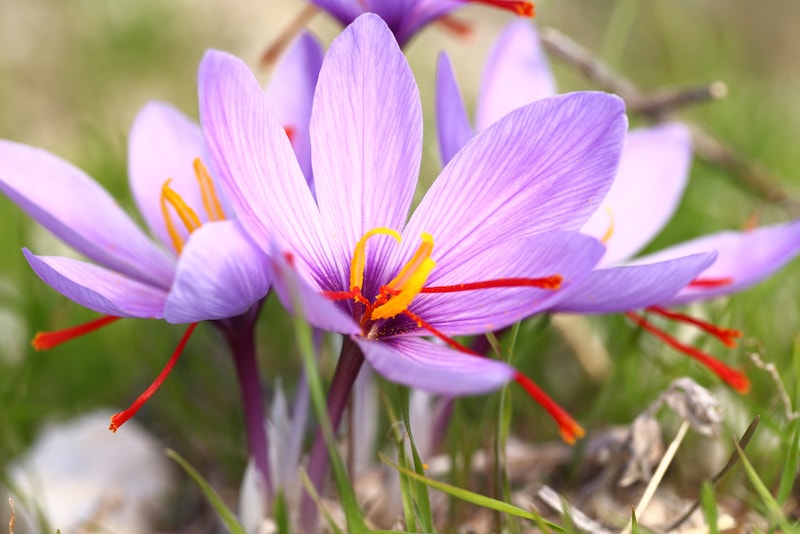Saffron, the world’s most expensive spice, is harvested from crocus sativus, the saffron crocus. Easy to grow from a corm, it not only provides a treat for the tastebuds but the pretty blooms make a gorgeous addition to your autumn garden.
Rich in taste, aroma and history this ancient spice has a legendary life all of its own – Zeus apparently slept on a bed of saffron while Queen Cleopatra was reputed to bathe in milk infused with it. Here’s everything you need to know about growing saffron crocuses in your own garden.
About saffron crocus
Saffron is thought to originate from Greece, but these days it’s produced commercially in Iran, Greece, Morocco and India, with over 90% of true saffron coming from Iran. In the UK, the Cornish have a traditional affinity for the spice, consuming saffron buns by the cartload!
In cultivation for at least 3500 years, crocus sativus is actually a corm rather than a true bulb. Unlike bulbs which store their nutrients in the succulent leaves surrounding the central stem, corms store their nutrients in the stem itself. The papery leaves act as protection for the stem, rather than a food source.
However, if you’re growing saffron crocus in your garden, treat it as you would a bulb. Plant in drifts from August to September and they will flower from October to November, becoming dormant once the foliage has died back.
The best place to grow saffron crocus

Image: White saffron crocus bulbs from Suttons
Saffron crocuses thrive in a sunny position and they need soil which dries out during the corms’ dormant phase, otherwise they’ll rot. Dry soils also help with the formation of flowers for the following autumn.
An ideal position for planting would be at the base of a south-facing wall, in a well-drained border. Alternatively, opt for containers which you can move into a greenhouse when the corms are dormant between April and September.
How to plant saffron crocus
Plant the corms 10-15cm (4-6″) deep and 10-15cm (4-6″) apart. Don’t go too deep because this results in fewer flowers.
Saffron crocuses usually begin to bloom around 40 days after planting and each bulb produces six or more mauve flowers over a two week period. Not all your corms will flower in the first year – some need time to adapt to the new conditions. You should feed your crocuses a balanced liquid fertiliser before the foliage dies back in April/May.
Each saffron corm lasts one season but is replaced by anything up to 10 new corms. These new corms grow above the old ones and this gradually forces the plant nearer the surface. For this reason, you should lift and replant your saffron crocuses every few years during their dormant phase in August.
How to harvest and store saffron
Just because you’re growing saffron crocuses mainly for their delicate blooms doesn’t mean you shouldn’t harvest their bright red filaments to flavour your cooking.
True saffron crocuses produce just three 25mm long filaments per bloom. This is important because, although other crocuses produce more threads, they’re not from the same plant family and their filaments are toxic.
Saffron is best picked early in the morning. As soon as the flower opens, use a pair of tweezers to carefully pluck out the threads. Place them on kitchen paper and put them in a dark, dry spot, like an airing cupboard until dry, and then store them in an airtight container in your kitchen cupboard until you’re ready to use them.
Delicate, evocative, and producing a deliciously expensive spice, if you have a sunny, free-draining spot to plant them, saffron crocuses are both easy and rewarding to grow.
Shop for saffron and other varieties of crocus bulbs online at Suttons.
Lead image: Shutterstock
Last Updated on September 30, 2025 by Suttons Horticultural Team







I have never grown Saffron Crocus before but I have a spare bed in my greenhouse soil so I am going to
Let the crocus bulbs have it to see if they like the soil and warmth. So can I plant the bulbs now and leave
Them to do their thing.. Rob.
Thank you for the information about growing saffron crocus. I’ve just received my order. It would be really helpful if you could put a print-friendly version of this on your website. Looking forward to my tiny harvest!
The close up photo above is Safflower not Saffron
Can someone confirm that if the crocus corm does not flower , there will be no ‘daughter corms’ forming on the main corm.
I have some saffron crocus bulbs and they come up each year but just look like blades of thin grass about 8 inches in length they have never flowered can i put them in a pot in the greenhouse or should i give up